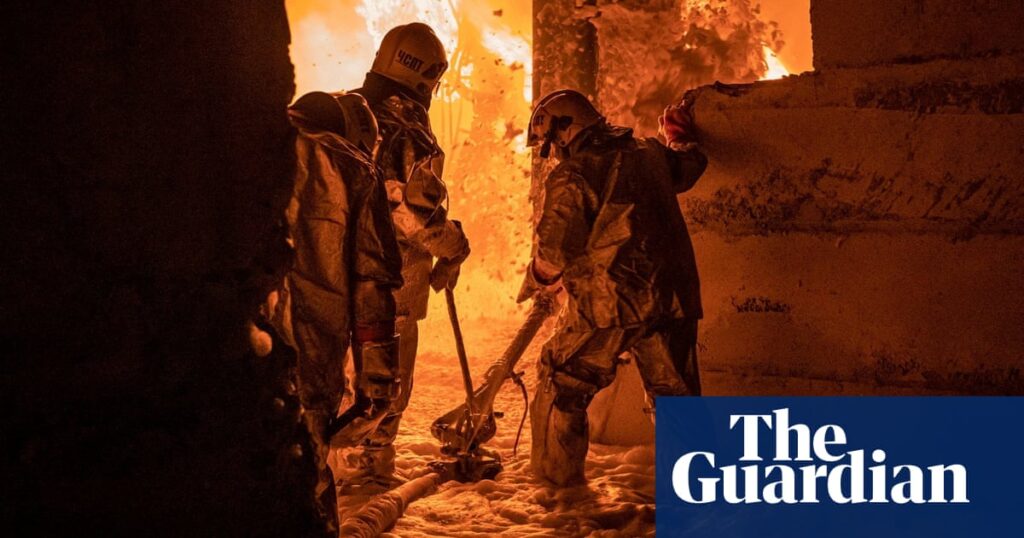Russia launched its largest-ever drone attack against Ukraine on Monday night and Tuesday morning, sending a reported 188 drones into the country and attacking various targets, resulting in attacks in parts of western Ukraine. A power outage occurred in the area, causing damage to residential buildings on the outskirts of Kiev.
Russian forces continue to push hard on the front lines in Russia’s east, amid uncertainty over how the dynamics of the war will change once Donald Trump takes office in January. Russia also vowed to take “retaliatory measures” against renewed Ukrainian attacks on military targets inside Russia using long-range missiles sent by the United States.
Ukraine’s air force said 76 drones were shot down overnight as its air defenses struggled to cope with group attacks that have become common in recent weeks. “The large-scale drone attack unfortunately resulted in damage to critical infrastructure facilities, including damage to civilian buildings and apartment buildings in several areas,” the Air Force said in a statement.
Vyacheslav Nekhoda, the governor of the western Ternopil region, said on television that about 70% of the region was without power. “The outcome is negative as facilities have been severely affected and will have long-term implications for power supply across the region.” Several buildings were damaged around Kiev, but no casualties were reported.
Also on Tuesday, a court in the Russian city of Kursk confirmed that a British national had been captured and arrested by Russian authorities. This was the first official confirmation of the news, which was reported over the weekend when the interrogation video was circulated on the Russian Telegram channel.
The court ordered James Scott Rees Anderson, 22, to be detained on suspicion of “participating in armed hostilities on the territory of the Kursk region.” He did not specify the exact charges, saying only that he had “committed a series of particularly serious crimes that posed a danger to society.”
Russian military bloggers said Anderson took part in a Ukrainian military offensive into Russian territory that began in late summer and was captured near the village of Prekhovo. Russian forces are currently on the offensive in the Kursk region, trying to regain control of lost territory.
In a video released over the weekend, the man, dressed in military uniform and with his hands tied, gives his name as Anderson and says he served in the British army from 2019 to 2023 before being fired and traveling to Ukraine. He said he had decided. And volunteer.
Foreign Secretary David Lamy said on Monday he was aware of the arrest and that authorities would “provide all possible support to this British national”.
Earlier this month, the United States gave Ukraine permission to use U.S.-supplied Atakumus missiles to attack military targets deep in Russia in support of Ukraine’s Kursk offensive. Britain followed suit and authorized the use of Stormshadow missiles in Russia.
On Tuesday, Bloomberg reported that Britain recently sent “dozens” of Storm Shadow aircraft to Ukraine. This will be Keir Starmer’s first transport since he became Prime Minister in July. A Ministry of Defense spokesperson declined to comment on the report. “We will not comment on the details of the operation. Doing so will only benefit President Putin,” he said, adding that Britain’s support for Ukraine was “ironclad”.
The decision to authorize attacks on targets inside Russia has infuriated the Kremlin, with President Vladimir Putin saying it amounted to a declaration of war against Russia and gave Russia the right to attack targets in countries that provided the weapons. He said he gave it.
Russia’s Ministry of Defense announced that Ukraine launched further attacks using Atakum against targets including air bases and air defense batteries in the Kursk region, causing an unspecified number of casualties and damage to equipment. It was a rare admission by Moscow that the Ukrainian military offensive had achieved its goals.
sign up for europe headlines
Get a digest of Europe’s main morning headlines sent straight to your email every week
Privacy Notice: Newsletters may include information about charities, online advertising, and content sponsored by external parties. Please see our Privacy Policy for more information. We use Google reCaptcha to protect our website and are subject to the Google Privacy Policy and Terms of Service.
After newsletter promotion
“Preparations are underway for retaliatory measures,” the ministry said in a Telegram post, without elaborating. The first strike using Atakum led to Russia’s use of an experimental ballistic missile against the city of Dnipro last week, prompting a response from President Vladimir Putin that suggested a nuclear option was being considered.
Both sides are trying to position themselves ahead of Trump’s return, who claims he can resolve the dispute within “24 hours” but has provided few details about how he will do so. .
Ukraine’s allies are also fiercely debating how best to continue supporting Kiev amid potential changes in U.S. policy. NATO Secretary-General Mark Rutte, who met with President Trump in Florida over the weekend, said Tuesday that NATO allies need to do more to support Kiev. “Our support to Ukraine has kept it fighting, but we need to go further to change the trajectory of the conflict,” he said in Athens, where he was visiting.
Rutte stressed the importance of strengthening the bloc’s “deterrence and defense” and said it was also important to boost investment and production in the arms industry.
“In pursuing an illegal war in Ukraine, Russia is using North Korean weapons and troops, Iranian drones, and Chinese munitions for its defense industry. This is a dangerous escalation of war and a global “This is a challenge to peace and security.”



